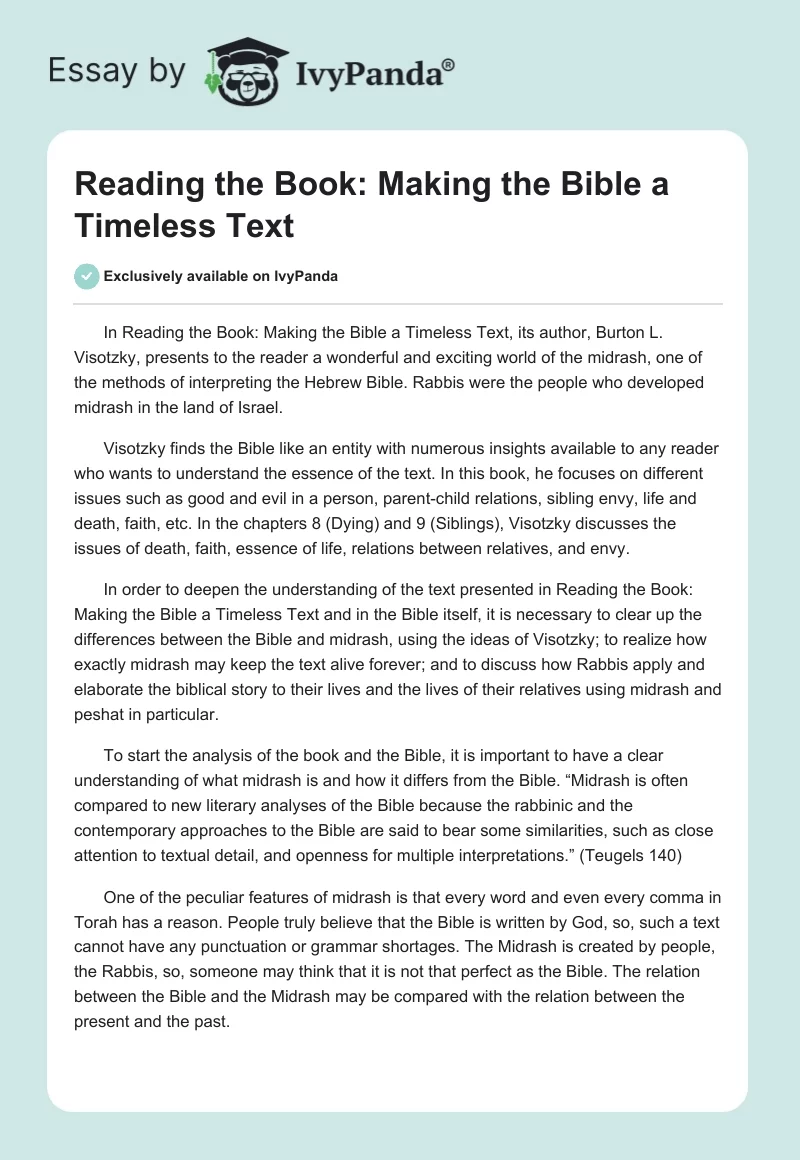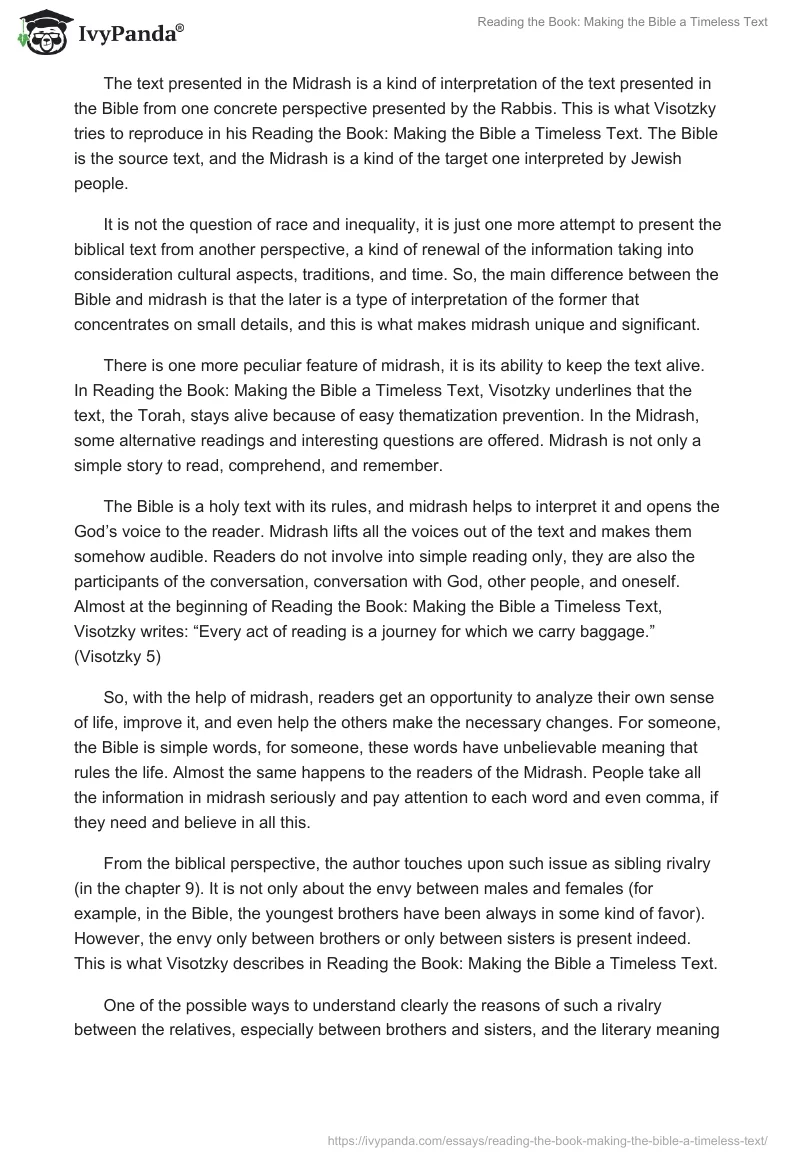In Reading the Book: Making the Bible a Timeless Text, its author, Burton L. Visotzky, presents to the reader a wonderful and exciting world of the midrash, one of the methods of interpreting the Hebrew Bible. Rabbis were the people who developed midrash in the land of Israel.
Visotzky finds the Bible like an entity with numerous insights available to any reader who wants to understand the essence of the text. In this book, he focuses on different issues such as good and evil in a person, parent-child relations, sibling envy, life and death, faith, etc. In the chapters 8 (Dying) and 9 (Siblings), Visotzky discusses the issues of death, faith, essence of life, relations between relatives, and envy.
In order to deepen the understanding of the text presented in Reading the Book: Making the Bible a Timeless Text and in the Bible itself, it is necessary to clear up the differences between the Bible and midrash, using the ideas of Visotzky; to realize how exactly midrash may keep the text alive forever; and to discuss how Rabbis apply and elaborate the biblical story to their lives and the lives of their relatives using midrash and peshat in particular.
To start the analysis of the book and the Bible, it is important to have a clear understanding of what midrash is and how it differs from the Bible. “Midrash is often compared to new literary analyses of the Bible because the rabbinic and the contemporary approaches to the Bible are said to bear some similarities, such as close attention to textual detail, and openness for multiple interpretations.” (Teugels 140)
One of the peculiar features of midrash is that every word and even every comma in Torah has a reason. People truly believe that the Bible is written by God, so, such a text cannot have any punctuation or grammar shortages. The Midrash is created by people, the Rabbis, so, someone may think that it is not that perfect as the Bible. The relation between the Bible and the Midrash may be compared with the relation between the present and the past.
The text presented in the Midrash is a kind of interpretation of the text presented in the Bible from one concrete perspective presented by the Rabbis. This is what Visotzky tries to reproduce in his Reading the Book: Making the Bible a Timeless Text. The Bible is the source text, and the Midrash is a kind of the target one interpreted by Jewish people.
It is not the question of race and inequality, it is just one more attempt to present the biblical text from another perspective, a kind of renewal of the information taking into consideration cultural aspects, traditions, and time. So, the main difference between the Bible and midrash is that the later is a type of interpretation of the former that concentrates on small details, and this is what makes midrash unique and significant.
There is one more peculiar feature of midrash, it is its ability to keep the text alive. In Reading the Book: Making the Bible a Timeless Text, Visotzky underlines that the text, the Torah, stays alive because of easy thematization prevention. In the Midrash, some alternative readings and interesting questions are offered. Midrash is not only a simple story to read, comprehend, and remember.
The Bible is a holy text with its rules, and midrash helps to interpret it and opens the God’s voice to the reader. Midrash lifts all the voices out of the text and makes them somehow audible. Readers do not involve into simple reading only, they are also the participants of the conversation, conversation with God, other people, and oneself. Almost at the beginning of Reading the Book: Making the Bible a Timeless Text, Visotzky writes: “Every act of reading is a journey for which we carry baggage.” (Visotzky 5)
So, with the help of midrash, readers get an opportunity to analyze their own sense of life, improve it, and even help the others make the necessary changes. For someone, the Bible is simple words, for someone, these words have unbelievable meaning that rules the life. Almost the same happens to the readers of the Midrash. People take all the information in midrash seriously and pay attention to each word and even comma, if they need and believe in all this.
From the biblical perspective, the author touches upon such issue as sibling rivalry (in the chapter 9). It is not only about the envy between males and females (for example, in the Bible, the youngest brothers have been always in some kind of favor). However, the envy only between brothers or only between sisters is present indeed. This is what Visotzky describes in Reading the Book: Making the Bible a Timeless Text.
One of the possible ways to understand clearly the reasons of such a rivalry between the relatives, especially between brothers and sisters, and the literary meaning of the text itself is the method of peshat. The author wonders: “Why should one prefer the midrash to the simple reading of the scriptural text, the peshat? (Visotzky 159).
Peshat is one of the methods that Jewish people use to comprehend the Hebrew bible. The literal meaning of this method underlines the simplicity. In other words, peshat is a kind of exegesis that presents the meaning of the text with the help of simple and comprehensible expressions for any reader. The purpose of peshat is to retain a clear literal understanding of the Bible narrative.
In the chapters 8 and 9 of Reading the Book: Making the Bible a Timeless Text, the method that we call “peshat” or “pshat” helps to understand that the personalities presented in the Bible relate to ordinary people with their personal experience, their own dreams, and principles. The biblical narratives are captivating and unique indeed. They have such a quality to pull the reader and burn a desire to read more and more.
In general, with the help of the Rabbis interpretation of the biblical text, people get one more opportunity to comprehend the information presented in the Bible that gathered during such a long period of time. The New Testament and the Old Testament are not always comprehensible to every reader.
If people take into consideration the variety of traditions, cultures, and time barrier, it will not be that easy to create one source that will be appropriate for any generation and any culture. The Midrash provides the readers with an opportunity to look at the familiar text in another light.
The professor of interreligious studies and midrash in particular, Burton L. Visotzky in his Reading the Book: Making the Bible a Timeless Text explains to the readers the grounds of the Bible from the Rabbis perspective. Such explanation helps to analyze the information in a different way. This book turns out to be interesting and understandable to people of any race, belief, and people with any religious background.
The interpretation offered by the Rabbis deepens our understanding in different ways: the readers realize that it is not that difficult to create and develop their own relationships grounding on the Bible, and present their own midrash. “Although midrash was mostly created by male rabbis, there is nothing to stop the modern writer and reader of the Bible from creating new midrash which re-examines texts that may be unfavorable and unsafe for women and re-fashions, re-interprets, and revises them.” (Graetz 19)
The ideas of jealousy, parenting, rivalry between siblings, responsibility, and faith presented in the book – this is exactly what rouses unbelievable interest in the readers’ mind. It helps to reveal a richness that the readers have not known or noticed before.
A new vision of the already analyzed and discussed problems, new ideas and suggestions – this is what the reader can get from the book Reading the Book: Making the Bible a Timeless Text by Visotzky.
A clear understanding of the differences between the Bible, and one of its interpretations, midrash, the factors, which prove that midrash keep the holy text alive forever, and the analysis of the Bible with the help of one midrash methods, peshat, help to comprehend deeper not only the sense of the book by Visotzky, but also the essence of the Bible.
Works Cited
Graetz Naomi. Unlocking the Garden: A Feminist Jewish Look at the Bible, Midrash and God. Gorgias Press LLC, 2005.
Teugels, Lieve, M. Bible and Midrash: the Story of “The Wooing of Rebekah”. Peeters Publisher, 2004.
Visotzky, Burton, L. Reading the Book: Making the Bible a Timeless Text. Random House, 1996.


